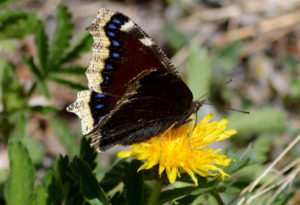It’s an old story. Another species that once flourished is being pushed to extinction by modern human encroachment. The callippe silverspot (Speyeria callippe callippe), federally listed as endangered in 1997, endemic to the San Francisco peninsula and East Bay Hills, has been gradually pushed into tiny remaining islands of habitat, including San Bruno Mountain south of San Francisco. Like many species, its needs are specific. It needs open hilltops for mating, and feeds only on the beautiful yellow Johnny jump-up (Viola pedunculata), where eggs are laid, caterpillars develop, and pupae form.
The federally endangered mission blue butterfly (Icaricia icarioides missionensis), although its extant range is larger than the callippe’s, also inhabits San Bruno Mountain. And the mountain is home to the San Francisco garter snake, federally listed as endangered in 1967, and at least a dozen plants listed by the California Native Plant Society as rare and endangered.
Luckily they have defenders. San Bruno Mountain Watch was established 30 years ago with a mission to “protect and preserve San Bruno Mountain as the largest and richest remaining example of the native Franciscan bioregion.” Today that mission takes them into a struggle with developer Brookfield Homes and the Brisbane City Council.
In 1983 the U.S. Fish and Wildlife Service prepared a Habitat Conservation Plan that protected 2,800 acres on the mountain from development forever. At the same time, they approved development of 300 acres around the edges of the mountain, most of which has been completed by now.
In 2009 Fish and Wildlife added another 20 acres to the protected area, and required developer Brookfield Homes to provide $4,000,000 for a permanent endowment to maintain the native habitat on the mountain. That money would fund ongoing efforts to maintain the kind of grassland habitats the butterflies prefer. That’s been a struggle, as exotic annual grasses and native scrub both take over more and more of the mountain.
“In the long term, whether the 20 acres are developed (or 40 acres as already permitted by our agency) is not likely to determine the fate of the butterflies,” Fish and Wildlife spokesman Al Donner wrote in an email to Bay Nature. “The fate of the magnificent butterflies on San Bruno Mountain will be determined by how well we as a society maintain the native habitat on the 2,800 acres of San Bruno Mountain that are protected.”
Nevertheless, San Bruno Mountain Watch Executive Director Ken McIntire says Fish and Wildlife has not lived up to the bargain. “Since 1983, 127 acres of grassland butterfly habitat has been lost to scrub,” he says. “If rare and endangered habitat is taken, then a reasonable plan would call for that habitat to be replaced. Now 26 years after the flawed plan, promises of habitat enhancement and revegetation haven’t panned out.”
The construction would split the callippe population into two separate groups. Says San Francisco State University Professor of Biology John Hafernik, “If the population is split, that puts them at great risk. Historically, population fragments go extinct.”
On January 19, the Brisbane City Council heard public comment on the issue. Twenty-three people spoke. Twenty were against the proposed development; three spoke in favor. On February 1, the council will hear public comment and vote to decide the future of the project. In 2007 they accepted an EIR addendum that found “no significant impacts” to the endangered callippe. Now they must vote accept or reject another addendum to the 1982 EIR.
SBMW says an entirely new EIR is needed. “The California Environmental Quality Act actually requires that environmental review consider present day problems of climate change, traffic, affordable housing, and water conservation,” says McIntire.
Further, the group has sued the County of San Mateo for its “negative declaration” that there found no substantial evidence the project may have a significant effect on the environment.
The best result, says McIntire, would be a “really viable corridor at least three hundred feet wide connecting with the northeast ridge habitat, containing ungraded grasslands, including ridges and some viola habitat, without any 4-lane roads or stands of eucalyptus.”
Further, McIntire contends, “We should broaden the discussion to include the fundamental flaws in the HCP. No more rare habitat should be paved over on the promises of a plan and some funds. A new scientific study of the callippe should be done to test the claims that all the barriers that have been put in the historic flight corridor won’t interfere with the butterfly. We cannot protect the mountain by speculating with endangered species habitat, as [Fish and Wildlife] is doing by allowing the destruction and isolation of that habitat as a means of funding the preservation of it.”

.jpg)



